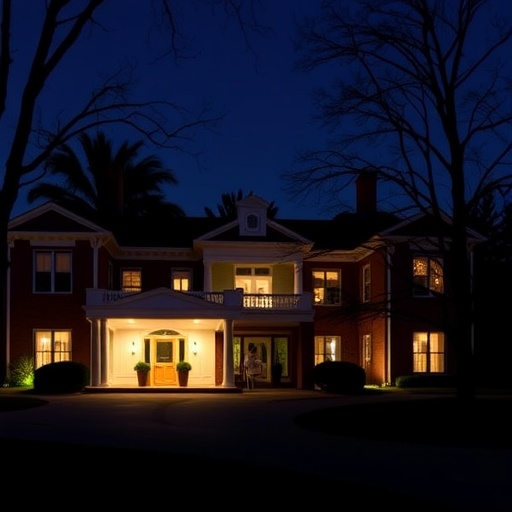In the decades following World War II, America’s burgeoning suburban landscape and expanding federal social welfare initiatives quietly converged to birth a new architectural and institutional phenomenon: the modern nursing home. While often overlooked in architectural history, nursing homes have played a pivotal role in shaping the landscape of healthcare and eldercare in the United States. A newly published article in the Journal of the Society of Architectural Historians illuminates this transformation by focusing on the innovative practices of the Americana Corporation, a mid-20th-century Illinois-based eldercare company that fundamentally reshaped the nursing home industry.
Willa Granger, Ph.D., assistant professor at Florida Atlantic University’s School of Architecture, has meticulously chronicled how the Americana Corporation developed a replicable model of hospital-adjacent, suburban nursing centers throughout the 1960s. These facilities not only redefined the physical environments of eldercare but also institutionalized new norms around care delivery, profitability, and federal oversight. Granger’s research draws on extensive archival materials—including business records, marketing literature, and governmental policy documentation—to expose the intricate relationship between architecture, healthcare policy, and corporate strategy in guiding the sector’s evolution.
The Americana Corporation’s model marked a decisive break from earlier eldercare arrangements, which were often fragmented and housed in converted residential buildings lacking medical oversight. Instead, Americana introduced purpose-built, single-story structures showcasing neocolonial architectural aesthetics. With brick facades, white porticos, and decorative shutters, these homes visually blended into suburban neighborhoods, all the while being internally configured with clinical, hospital-grade layouts. This architectural duality—comforting exteriors coupled with rigorous internal medical functionality—was central to Americana’s branding and operational ethos, reflecting a growing cultural preference for institutionalized eldercare that was both familiar and professional.
What set Americana apart was its strategic siting next to larger regional hospitals in burgeoning suburban and rural areas, a deliberate choice that navigated the emerging healthcare ecosystem’s complexities. Their design philosophy embraced lessons from the motel industry’s surge, employing standardization, franchising tactics, and real estate development strategies to ensure efficient scalability and consistent service delivery across multiple states. By 1969, Americana boasted over 30 facilities in nine states—a testament to its rapid expansion underpinned by astute architectural and business models.
Federal social programs played an indispensable role in Americana’s rise. The Hill-Burton Act, Social Security expansions, and especially Medicare established financial incentives and regulatory frameworks that both enabled and constrained the growth of nursing homes. These policies encouraged the medicalization and professionalization of eldercare, funneling public funds into private-sector providers willing to meet increasingly stringent safety and operational standards. Americana adeptly navigated this emerging policy landscape, aligning its architectural designs and business practices to comply with evolving licensure mandates, thereby leveraging government support to scale its network.
Granger’s article crucially reframes nursing homes not merely as healthcare facilities but as constructed environments imbued with social values, economic imperatives, and policy influences. The Americana Corporation’s work epitomizes how architecture actively participates in producing social realities—shaping perceptions of aging, caregiving, and institutional responsibility. Far from neutral, these buildings embody midcentury America’s tensions: the balance between profit motives and human dignity, standardization versus individualized care, and medical necessity against community integration.
An important comparative dimension in the study contrasts Americana’s model with earlier, often subpar operations exemplified by figures like Leonard Tilkin, whose Chicago-area nursing homes suffered from chronic understaffing and poor conditions, operating out of repurposed historic homes. Americana’s adherence to regulatory compliance and architectural intentionality raised the bar for acceptable eldercare facilities, signaling a shift toward corporate-driven, scalable care institutions. However, this shift also introduces complexities surrounding depersonalization and the commodification of care, raising ethical considerations still relevant today.
The article invites reflection on the enduring legacy of this architectural-medical-commercial nexus as the U.S. grapples with an aging population and escalating pressures on long-term care infrastructures. It underscores that the built environment is not simply a backdrop but an active participant in shaping healthcare experiences and outcomes. The physical form of eldercare buildings reflects prevailing cultural attitudes and economic structures, which continue to influence how society treats its most vulnerable members.
As old nursing home models give way to new care paradigms, including assisted living and home-based services, understanding Americana’s foundational role offers critical insights into both the possibilities and pitfalls of institutional design and healthcare policy integration. Granger’s findings compel policymakers, architects, and healthcare professionals to consider how future eldercare systems might better balance humane treatment with operational viability, all within an architectural framework that fosters dignity and community connection.
Ultimately, this research enhances the dialogue surrounding the intersection of architecture, healthcare, and society—not only by chronicling a forgotten chapter in American history but by illuminating pathways toward more compassionate, effective care environments. It exemplifies how historical analysis enriches contemporary debates about aging, caregiving, and the built environment’s role in political economy and social welfare.
By foregrounding architecture as a mediator of care and an instrument of policy enactment, Granger’s work reframes nursing homes as more than just places of residence or medical service. They emerge as complex socio-economic systems shaped by federal legislation, corporate ambitions, and cultural narratives about aging. Examining this convergence provides a potent lens to evaluate and reimagine eldercare architecture amid 21st-century demographic and healthcare challenges.
In revealing the layered histories behind the Americana Corporation’s rise, the article offers a profound reminder that architecture and healthcare systems are co-constitutive forces. They govern how societies care for aging populations and shape the lived realities of millions nationwide. By unpacking the physical and institutional infrastructures of care, Granger’s study contributes a vital chapter to architectural history, medical sociology, and public policy discourse.
Subject of Research: Not applicable
Article Title: Consuming Care: The Americana Corporation and the Advent of the Modern Nursing Home
News Publication Date: 1-Sep-2025
Web References: http://dx.doi.org/10.1525/jsah.2025.84.3.386
Image Credits: Willa Granger, Ph.D. (author)
Keywords: Architecture, Architectural design, Nursing homes, History of medicine, Industrial revolution, Medical facilities, Hospitals, Western medicine, Public health, Caregivers, Economic history, Business, Corporations, Marketing, Economics, Gerontology, United States population, Aging populations




